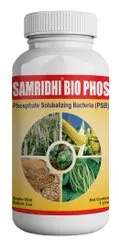Phosphate Solubilizing Bacteria
₹1,000.0
Product Details:
| Minimum Order Quantity | 1000 Litre |
| Packaging Type | 500ml,1 Liter,50 Liter,200 Liter |
| Types Of Biofertilizers | Phosphate Solubilizing Bacteria |
| Usage/Application | Agriculture,Fertilizer |
| Pack Type | Bottles,Drums |
| Usage | Agriculture,Fertilizer |
| Pack Size | 500ml,1 Liter,5 Liter,200 Liter |
| Form | Liquid |
| Packaging Size | 500ml,1 Liter,200 Liter Bottles,Drums |
| Dosage | 500ml – 1 liter/ Acre |
| Ph Value | 5.0 – 7.0 |
| Technical Name | Phosphate Solubalizing Bacteria |
| All Crops | Yes |
| Country of Origin | Made in India |
|
COMPONENTS |
|
CONTENTS |
|
Base |
|
Liquid |
|
Viable Cell Count |
|
1 x108 cell / ml of liquid |
|
Contamination level |
|
No contamination at 105 dilution |
|
pH |
|
5.0 – 7.5 |
|
Efficiency character |
|
Phosphate Solubilizing capacity 30 % (min.) |
Due to immobilization of phosphate by mineral ions such as Fe, Al and Ca and organic acids,the rate of available phosphate in soil is well below plant needs. Chemical fertilizers are also immobilized in the soil, immediately so that only 20% of added fertilizer is absorbed by plants.PSB converting insoluble phosphatic compounds such as rock phosphate, bone meal and basic slag particularly the chemically fixed soil phosphorus into available form. Such organism not only assimilates phosphorus but also cause a large amount of soluble phosphate to be released in excess of their own requirements and saves P2O5 up to 30 – 50 Kg/ ha. Phosphorus solubilizing activity is determined by the ability of microbes to release metabolites such as organic acid (lactic acid, malic acid, gluconic acid, fumaric acid, succinic and acetic acid). Inorganic phosphorus is solublizedby action of organic (gluconic, ketogluconic) and inorganic acids (Hcl) secreted by PSB and maintain the soil pH. The pH of rhizospheree is lowered the bio-carbonates release (anions/cation balance) and oxygen/carbon oxide gaseous exchange.Phosphorus solubilizing ability of PSB has direct correlation with pH of the medium.
Target crops:
Cereals (Wheat, Paddy, Maize, Barley),Pulses(Soybean, Green gram, Chickpea, Black gram,pea Pea), Oil seeds (Sunflower, Ground Nut, Mustard, Coconut, Safflower), Fibrous(Cotton, Jute), Vegetables, Fruit and Plantation crops
Benefits to the crop:
- Increase micronutrients availability to plant from the soil like Mn, Mg, Fe, Mo, B, Zn and Cin addition to P2O5.
- Encourage faster root growth for water and nutrient uptake.
- PSB produce organic acids like malic, succinic, fumaric, citric, tartaric acid and acetic acid
- which fasten the P2O5 up take, maturity and increase yield.
- Increase resistance towards diseases and drought tolerance due to rapid cell developmen in the plants.
- Compatible to other beneficial microbes with the plant like growth promoting substance.
- Reduce 25 – 30% phosphatic fertilizer requirement.
Method of application
- Seed Treatment – Apply 10 ml in 1.0 kg of seeds and add sufficient quantity of water. Mix the entire seed with prepared mixture for coating the seeds, dry under shade and sow the seed early morning or late evening.
- Soil Treatment – Apply 500ml – 1 lit. /acr in 50kg well decompose Fym/compost/vermi compost/field soil thoroughly and broadcast in the field before sowing/planting or in the standing crop.
- Seedlings Treatment – Mix 100 ml in 10 lit. of water and dip the seedlings root for 20 – 30 minutes
You must be logged in to post a review.
Q & A
Organic fertilizers release nutrients slowly, reducing the risk of nutrient runoff and pollution of water bodies compared to fast-release synthetic fertilizers that can cause harmful algal blooms and damage aquatic ecosystems.
Organic fertilizers can be produced from agricultural and food waste, contributing to waste reduction and recycling efforts.
However, it's important to note that the sustainability of organic fertilizers can vary depending on factors such as the source and production methods, transportation, and local environmental conditions. Additionally, organic fertilizers may have lower nutrient concentrations than synthetic ones, which can require larger quantities and more land for production.
General Inquiries
There are no inquiries yet.





Reviews
There are no reviews yet.